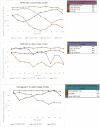Hidden heterogeneity: Uncovering patterns of adherence in microbicide trials for HIV prevention
- PMID: 35551324
- PMCID: PMC9098085
- DOI: 10.1371/journal.pone.0267011
Hidden heterogeneity: Uncovering patterns of adherence in microbicide trials for HIV prevention
Abstract
Background: Interpretation of clinical trial results testing vaginal microbicide gels for HIV prevention depends on participant adherence. Prior to the era of antiretrovirals, microbicide trials collected adherence data via self-report, and trials typically reported trial population adherence as overall averages in primary results manuscripts. This study first sought to determine if different patterns of adherence from three trials of vaginal microbicide gels could be identified, using self-reported data and if so, how those patterns compare across trials. The second objective was to explore which individual-level factors were associated with different adherence patterns.
Methods: Data from the following three clinical trials of vaginal microbicides were used for this study: HIV Prevention Trials Network (HPTN) 035 testing PRO 2000 and Buffergel, the Microbicides Development Programme (MDP) 301 testing PRO 2000, and the Population Council's Carraguard study, testing Carraguard gel. Latent Class Analysis (LCA) was used to identify longitudinal patterns of adherence using self-reported data about gel use. Multinomial multivariable logistic regression was used to estimate relative risk-ratios for factors which were independently associated with different latent adherence trajectories within each trial, and compared across trials.
Results: Included in this analysis are 2,282 women from HPTN 035 (age 17-56 years), 6238 women from MDP 301 (age 16-75 years), and 6039 women from Carraguard (age 16-73 years). Using LCA, 3-4 different patterns of gel adherence were identified in each trial; these patterns were similar across the trials. Factors associated with adherence patterns were identified in all trials. Older age was associated with the adherence trajectory that consistently reported gel use in three trials. Participant-reported negative reaction of partners to the gel was associated with trajectories that reported less consistent adherence in two trials. A greater number of baseline-reported sex partners or sex acts was associated with trajectories which reported less consistent adherence in some trials. Trial site location was associated with membership of trajectories in all trials.
Conclusion: LCA was able to identify patterns of microbicide gel adherence in clinical trials that used self-reported data. Key factors associated with patterns of adherence in this study were participant age, clinical trial site location, and partner reaction to the study gel. These findings, in particular, age and perceived partner reaction to the method, are consistent with results from other clinical trials and programmatic rollout of biomedical HIV prevention methods for women in Africa. This study contributes to the body of evidence that women need more support to navigate power dynamics within their relationships with men so that they can successfully use HIV prevention methods.
Conflict of interest statement
The authors have declared that no competing interests exist.
Figures
Similar articles
-
Prevention, Partners, and Power Imbalances: Women's Views on How Male Partners Affected Their Adherence to Vaginal Microbicide Gels During HIV Prevention Trials in Africa.J Acquir Immune Defic Syndr. 2020 Dec 1;85(4):458-465. doi: 10.1097/QAI.0000000000002463. J Acquir Immune Defic Syndr. 2020. PMID: 33136745 Free PMC article.
-
Optimizing HIV prevention for women: a review of evidence from microbicide studies and considerations for gender-sensitive microbicide introduction.J Int AIDS Soc. 2015 Dec 21;18(1):20536. doi: 10.7448/IAS.18.1.20536. eCollection 2015. J Int AIDS Soc. 2015. PMID: 26700845 Free PMC article. Review.
-
Effects of partnership change on microbicide gel adherence in a clinical trial (HPTN 035).AIDS Behav. 2014 May;18(5):855-61. doi: 10.1007/s10461-013-0651-5. AIDS Behav. 2014. PMID: 24158488 Free PMC article. Clinical Trial.
-
Acceptability of Carraguard vaginal microbicide gel among HIV-infected women in Chiang Rai, Thailand.PLoS One. 2011;6(9):e14831. doi: 10.1371/journal.pone.0014831. Epub 2011 Sep 7. PLoS One. 2011. PMID: 21915249 Free PMC article. Clinical Trial.
-
Topical microbicides for preventing sexually transmitted infections.Cochrane Database Syst Rev. 2021 Mar 13;3(3):CD007961. doi: 10.1002/14651858.CD007961.pub3. Cochrane Database Syst Rev. 2021. PMID: 33719075 Free PMC article.
Cited by
-
High adherence to intermittent and continuous use of a contraceptive vaginal ring among women in a randomized controlled trial in Kigali, Rwanda.Front Glob Womens Health. 2024 Apr 11;5:1278981. doi: 10.3389/fgwh.2024.1278981. eCollection 2024. Front Glob Womens Health. 2024. PMID: 38680542 Free PMC article.
-
Optimizing the pipeline of multipurpose prevention technologies: opportunities across women's reproductive lifespans.Front Reprod Health. 2023 May 30;5:1169110. doi: 10.3389/frph.2023.1169110. eCollection 2023. Front Reprod Health. 2023. PMID: 37325241 Free PMC article. Review.
References
-
- Skoler-Karpoff S, Ramjee G, Ahmed K, Altini L, Plagianos MG, Friedland B, et al.. Efficacy of Carraguard for prevention of HIV infection in women in South Africa: a randomised, double-blind, placebo-controlled trial. Lancet. 2008. Dec 6;372(9654):1977–87. doi: 10.1016/S0140-6736(08)61842-5 - DOI - PubMed
-
- Rees H, Delany-moretlwe S, Lombard C, Baron D, Panchia R, Myer L, et al. FACTS 001 Phase III Trial of Pericoital Tenofovir 1% Gel for HIV Prevention in Women. In: Conference on Retroviruses and Opportunistic Infections. Seattle, USA; 2015. p. 26LB.
-
- Kreiss J, Ngugi E, Holmes K, Ndinya-Achola J, Waiyaki P, Roberts PL, et al.. Efficacy of nonoxynol 9 contraceptive sponge use in preventing heterosexual acquisition of HIV in Nairobi prostitutes. JAMA. 1989;268(4):477–82. - PubMed
Publication types
MeSH terms
Substances
Grants and funding
LinkOut - more resources
Full Text Sources
Medical
Research Materials


